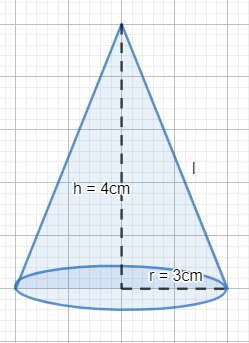
A self-help group wants to manufacture joker’s caps (conical shapes) of 3 cm radius and 4 cm height. If the available colour paper sheet is 1000 $c{{m}^{2}}$, then how many caps can be manufactured from that paper sheet?
Answer
570.6k+ views
Hint: First, we need to understand that cones are formed by folding papers. The paper required will be equal to the curved surface area of the cone as they are caps and need to be followed and open from below. With the help of the given height and base radius, we will find the slant height of the cone. Once we get the slant height, we can find the curved surface area of the cone given by the relation $S=\pi rl$, where r is the base radius and l is the slant height of the cone. Once we find the used by one cap, we can use a unitary method to find the number of caps that can be manufactured.
Complete step-by-step answer:
It is given to us that the joker’s caps are conical in shape, with the base radius as 3 cm and the height as 4 cm.
The cone will look as follows:

We can see that the height, slant height and the base radius form a right angled triangle. The slant height is the hypotenuse of the triangle.
Thus, we can find the slant height with the help of Pythagoras theorem.
$\begin{align}
& \Rightarrow {{l}^{2}}={{r}^{2}}+{{h}^{2}} \\
& \Rightarrow {{l}^{2}}={{\left( 3 \right)}^{2}}+{{\left( 4 \right)}^{2}} \\
& \Rightarrow {{l}^{2}}=9+16 \\
& \Rightarrow {{l}^{2}}=25 \\
& \Rightarrow l=5 \\
\end{align}$
Hence, the slant height of the conical cap is 5 cm.
We know that the curved surface area of a cone is given by the formula $S=\pi rl$.
$\begin{align}
& \Rightarrow S=\pi \left( 3 \right)\left( 5 \right) \\
& \Rightarrow S=3.14\left( 15 \right) \\
& \Rightarrow S=47.12 \\
\end{align}$
Hence, the area of paper required for one cap is 47.12 $c{{m}^{2}}$.
The available area of sheet available with us 1000 $c{{m}^{2}}$. Therefore, we can find the number of caps as the quotient of the total sheet available with us and the area of sheet required for one cap.
$\begin{align}
& n=\dfrac{1000}{47.12} \\
& n=21.22 \\
\end{align}$
Therefore, 21 caps can be manufactured.
Note: The unitary method helps us to find the final resources required for something, if we know the resources required for one unit and number of units to be produced. We can tweak this according to our requirement.
Complete step-by-step answer:
It is given to us that the joker’s caps are conical in shape, with the base radius as 3 cm and the height as 4 cm.
The cone will look as follows:

We can see that the height, slant height and the base radius form a right angled triangle. The slant height is the hypotenuse of the triangle.
Thus, we can find the slant height with the help of Pythagoras theorem.
$\begin{align}
& \Rightarrow {{l}^{2}}={{r}^{2}}+{{h}^{2}} \\
& \Rightarrow {{l}^{2}}={{\left( 3 \right)}^{2}}+{{\left( 4 \right)}^{2}} \\
& \Rightarrow {{l}^{2}}=9+16 \\
& \Rightarrow {{l}^{2}}=25 \\
& \Rightarrow l=5 \\
\end{align}$
Hence, the slant height of the conical cap is 5 cm.
We know that the curved surface area of a cone is given by the formula $S=\pi rl$.
$\begin{align}
& \Rightarrow S=\pi \left( 3 \right)\left( 5 \right) \\
& \Rightarrow S=3.14\left( 15 \right) \\
& \Rightarrow S=47.12 \\
\end{align}$
Hence, the area of paper required for one cap is 47.12 $c{{m}^{2}}$.
The available area of sheet available with us 1000 $c{{m}^{2}}$. Therefore, we can find the number of caps as the quotient of the total sheet available with us and the area of sheet required for one cap.
$\begin{align}
& n=\dfrac{1000}{47.12} \\
& n=21.22 \\
\end{align}$
Therefore, 21 caps can be manufactured.
Note: The unitary method helps us to find the final resources required for something, if we know the resources required for one unit and number of units to be produced. We can tweak this according to our requirement.
Recently Updated Pages
Two men on either side of the cliff 90m height observe class 10 maths CBSE

What happens to glucose which enters nephron along class 10 biology CBSE

Cutting of the Chinese melon means A The business and class 10 social science CBSE

Write a dialogue with at least ten utterances between class 10 english CBSE

Show an aquatic food chain using the following organisms class 10 biology CBSE

A circle is inscribed in an equilateral triangle and class 10 maths CBSE

Trending doubts
The shortest day of the year in India

Why is there a time difference of about 5 hours between class 10 social science CBSE

Write a letter to the principal requesting him to grant class 10 english CBSE

What is the median of the first 10 natural numbers class 10 maths CBSE

The Equation xxx + 2 is Satisfied when x is Equal to Class 10 Maths

What is the missing number in the sequence 259142027 class 10 maths CBSE




